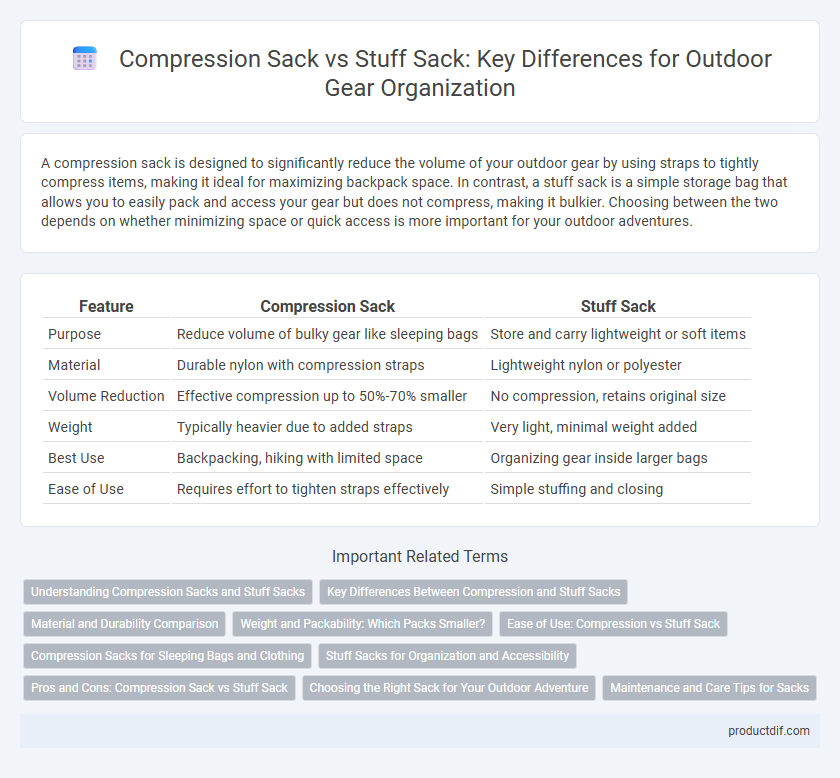A compression sack is designed to significantly reduce the volume of your outdoor gear by using straps to tightly compress items, making it ideal for maximizing backpack space. In contrast, a stuff sack is a simple storage bag that allows you to easily pack and access your gear but does not compress, making it bulkier. Choosing between the two depends on whether minimizing space or quick access is more important for your outdoor adventures.
Table of Comparison
| Feature | Compression Sack | Stuff Sack |
|---|---|---|
| Purpose | Reduce volume of bulky gear like sleeping bags | Store and carry lightweight or soft items |
| Material | Durable nylon with compression straps | Lightweight nylon or polyester |
| Volume Reduction | Effective compression up to 50%-70% smaller | No compression, retains original size |
| Weight | Typically heavier due to added straps | Very light, minimal weight added |
| Best Use | Backpacking, hiking with limited space | Organizing gear inside larger bags |
| Ease of Use | Requires effort to tighten straps effectively | Simple stuffing and closing |
Understanding Compression Sacks and Stuff Sacks
Compression sacks are designed to minimize the volume of bulky outdoor gear by using adjustable straps that tighten around the contents, making them ideal for backpacking and maximizing pack space. Stuff sacks serve as simple storage bags that protect gear from dirt and moisture but do not reduce bulk or volume significantly. Choosing between compression sacks and stuff sacks depends on the need for space-saving efficiency versus basic protection and organization.
Key Differences Between Compression and Stuff Sacks
Compression sacks reduce packed volume by using adjustable straps that tighten the bag around its contents, making them ideal for space-saving in backpacks. Stuff sacks rely on simply stuffing gear inside without compression, offering quicker access and simpler packing but resulting in a larger packed size. The key difference lies in compression sacks enhancing packability and minimizing volume, while stuff sacks prioritize ease of use and speed.
Material and Durability Comparison
Compression sacks are typically crafted from high-denier nylon or polyester with reinforced stitching to withstand repeated pressure and reduce packed volume, making them highly durable for strenuous outdoor activities. Stuff sacks often use lighter, less robust materials such as ripstop nylon or silicone-coated fabrics focused on simplicity and quick access rather than maximum compression or heavy wear resistance. The material strength and construction directly impact the lifespan and functionality, with compression sacks offering superior durability for extended use in harsh environments.
Weight and Packability: Which Packs Smaller?
Compression sacks are engineered to minimize volume by using adjustable straps that compress the contents, making them lighter and more compact for efficient packing. Stuff sacks lack compression features, resulting in bulkier packs that occupy more space and add unnecessary weight. Choosing a compression sack enhances packability by reducing both size and weight, ideal for lightweight backpacking and space-saving needs.
Ease of Use: Compression vs Stuff Sack
Compression sacks offer enhanced ease of use by incorporating adjustable straps or buckles that allow users to reduce the volume of their gear efficiently, making them ideal for optimizing backpack space during outdoor adventures. Stuff sacks provide straightforward access and quick packing by simply stuffing items inside without the need for tightening, which benefits users who prioritize speed over compactness. Choosing between compression and stuff sacks depends on the balance of convenience and space-saving needs in hiking, camping, or backpacking scenarios.
Compression Sacks for Sleeping Bags and Clothing
Compression sacks for sleeping bags and clothing maximize space efficiency by tightly reducing volume through adjustable straps or cords, making them ideal for backpacking and camping. Their durable, water-resistant materials protect gear from moisture and dirt while maintaining compactness, enhancing portability during outdoor adventures. Unlike stuff sacks that simply store items without volume reduction, compression sacks optimize packing space, enabling hikers to carry more essential gear comfortably.
Stuff Sacks for Organization and Accessibility
Stuff sacks are essential for organizing outdoor gear by providing easy access and efficient packing in backpacks. Their lightweight, versatile design allows for quick retrieval of clothes or equipment without unpacking the entire bag. Unlike compression sacks, stuff sacks prioritize accessibility and compartmentalization, making them ideal for items that require frequent use during outdoor activities.
Pros and Cons: Compression Sack vs Stuff Sack
Compression sacks excel in reducing bulk by using straps to tightly compress sleeping bags or clothing, ideal for lightweight backpacking where space savings are crucial. Stuff sacks offer quick and easy packing without compression, making them versatile and better suited for gear that doesn't require space optimization but demands easy access. Compression sacks can add weight due to straps and buckles, while stuff sacks prioritize simplicity and lightness, but result in larger pack volume.
Choosing the Right Sack for Your Outdoor Adventure
Compression sacks maximize space efficiency by reducing the volume of bulky gear like sleeping bags and clothing, making them ideal for backpackers prioritizing lightweight packing. Stuff sacks offer easy access and quick storage without compressing contents, perfect for casual hikers or campers needing convenience over space-saving. Selecting the right sack depends on the gear type, trip duration, and the importance of minimizing pack size versus ease of use.
Maintenance and Care Tips for Sacks
To prolong the lifespan of compression sacks and stuff sacks, regularly clean them with mild soap and water, avoiding harsh detergents that can degrade fabric coatings. Store sacks completely dry and in a loose, uncompressed state to prevent mold growth and material fatigue. Inspect seams and closures frequently for damage, and apply waterproof treatments if the sacks show signs of reduced water resistance.
Compression sack vs Stuff sack Infographic

 productdif.com
productdif.com